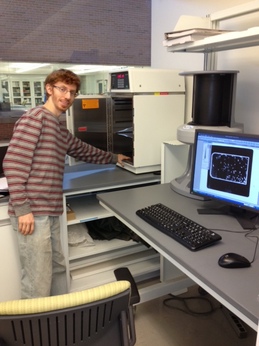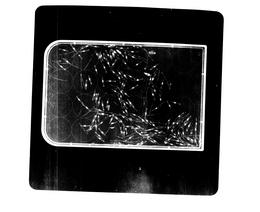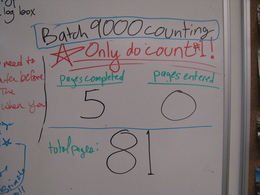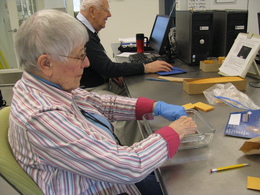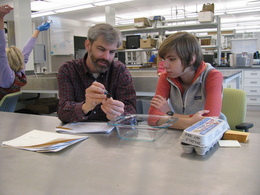|
|
By Marie Schaedel
Most Echinacea heads have achenes with a clear weight gap between full and empty, which is useful for lab purposes. Sometimes, however, there is no clear difference in weight for full and empty achenes. This winter, I took a closer look at achenes from Echinacea heads that had a continuous pattern of variation in weight to see if there was another way to distinguish between full and empty achenes when the weight test failed. To do this, I reweighed achenes from 20 samples that lacked an obvious weight cutoff. After plotting the new weights in R, I gathered X-ray images of the achenes closest to my best-guess cutoff weight for each sample. I found that more than half of the samples I tested had an intermediate transition weight that divided the full from empty populations of achenes. For ambiguous cases in which there is no clear difference in weight between full and empty achenes, this transition weight can be used to predict the cutoff value.
Read more:What to do when the Weight Test Fails.pdfAppendix
Figures

Figure 1

Figure 2

Figure 3

Figure 4

Figure 5
X-Ray Images

12139.1_top_red

14011.1_bot_bac

14142.1_bot_wht

14142.1_top_wht

14142.2_bot_grn

14142.2_top_grn

14143.1_bot_grn

14143.1_top_grn

14143.2_bot_wht

14963.2_bot_bac

14963.2_top_bac

17019.1_bot_wht

17019.1_top_wht

17134.2_bot_wht

17134.2_top_wht

17172.1_bot_red

17172.1_top_red

17294.1_bot_clr

17294.1_top_clr

6417.1_top_blu
Photograph Images

12139.1_top_red: Close-up of two achenes with a transition weight

14142.1_top_wht: Close-up of two achenes with a transition weight




















David Lowenstein, a PhD student from University of Illinois at Chicago, came to the lab at the Chicago Botanic Garden in December to use our x-ray machine for his research project. One of the species he using in his project is Echinacea purpurea.

David x-raying a sample of Echinacea fruits (achenes).
Here’s what David had to say about his project…
I am studying pollinators in Chicago and whether vegetable crops and wild flowers in various neighborhoods in Chicago receive sufficient pollination. To investigate this, I used a mobile garden consisting of eggplant, cucumber, and purple coneflower. Potted plants of these species were transported to Chicago neighborhoods and left outside for four and half hours. I observed bee visits to focal plants, sampled the neighborhood floral community, and allowed the plants to mature under pollinator exclusion netting in the UIC greenhouse to measure pollination services. I measured pollination of purple coneflower by X-raying the achenes at the Chicago Botanic Garden and recording the proportion of full achenes from each Echinacea flowerhead. I found a positive relation between bee abundance and human population density, and I will use data from X-rayed achenes to determine if pollination services are also related to population density or other land cover variables. To read more about this project that will continue in summer 2013, visit http://www.uic.edu/labs/minor/urban_pollination.html
Here are three of his x-ray images. If you click & enlarge these images, you will see that some achenes are empty and others have embryos.



Mindy Runge & Ale Mendoza participated in a mini-internship in the Echinacea lab at the Chicago Botanic Garden this fall. They are in Lynn Westley’s Plant Biology class at Lake Forest College.
Mindy & Ale investigated seed set in Echinacea heads from a prairie remnant in western Minnesota. They compared seed set in tops and bottoms of heads (florets at the bottom of a head flower first). In the process of answering their question, they learned how to dissect achenes from Echinacea seed heads, how to operate our high-tech seed balance, and how to organize datasets.

Ale and Mindy dissecting seedheads
This week we said goodbye to many of the students and volunteers who are traveling for the holiday season. Maria Wang left behind her dicanthelium to travel to visit with family in the UK. One of our volunteers, Bill W., is preparing for a trip to Panama. While a few people will be coming in next week, we won’t see most of our volunteers until next year. We’ve made a lot of progress in the past few months. Here is a brief summary of what we’ve accomplished since September:
1. New faces
We hosted several new interns this fall. Five students from Lakeforest College completed a four week internship on various projects (you can read about some of their work on the flog) . Marie (Carleton College) has been doing great work for an ongoing study on flowering phenology in prairie remnants. We will miss her when she goes back to school.
2. Lots and lots of counting
We have made a big dent in counting the achenes harvested in 2011 from the main experimental plot. We finished all counting for the 1999 experiment (4000s batch) and have begun counting for the rest of the 2011 harvest. And of course, no counting endeavor would be complete without a motivational whiteboard graphic.

3. New protocols
Because there are relatively few Echinacea heads to process from this year, we have an opportunity to try out different protocols and improve our methods. Our new protocol for selecting a random sample of seeds will improve our ability to assess pollination based on seed weight. We are also trying out new techniques for extracting seed heads and separating the dust.

That about sums it up. These details (protocols, cleaning, etc.) may seem minor, but they are important for creating reliable data.
LFC students Marissa Ruiz and Courtney King created this fabulous poster using samples from my 2012 Helianthus experiment for my thesis. Indeed, we have significant support for the self-incompatibility of the genus.

Bio 384 poster final.pdf
We are making progress on the 2012 harvest. Today, volunteers Lois and Susan are extracting achenes from Echinaea heads and placing them in envelopes. For this batch of heads, we are trying out a protocol of saving any leftover plant dust in separate envelopes.

We also have a lot to finish from the 2011 harvest. On Friday we started counting achenes from an experiment that examines the effects of burning on offspring fitness. Each plant came from a mother that was either burned or unburned the year before germination.
In other news, we have a new member of the lab. Marie is a sophomore from Carleton College and is taking advantage of her winter break to gain some research experience. This month she will be processing some of the heads from Kelly’s Kapsar’s project on flowering phenology. Today, Stuart taught her how to extract achenes.

|
|






























